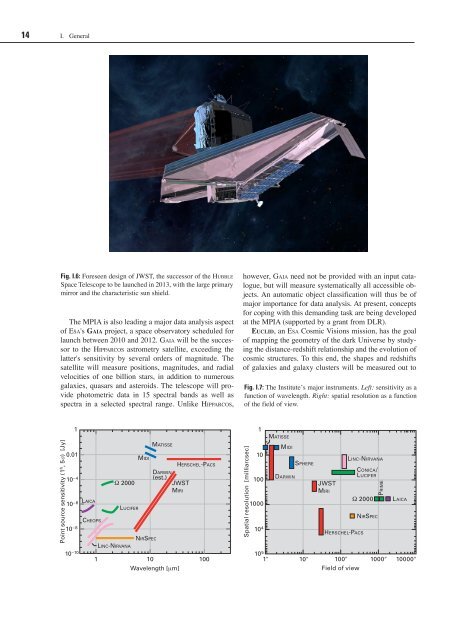Max Planck Institute for Astronomy - Annual Report 2007
Max Planck Institute for Astronomy - Annual Report 2007
Max Planck Institute for Astronomy - Annual Report 2007
Create successful ePaper yourself
Turn your PDF publications into a flip-book with our unique Google optimized e-Paper software.
14 I. General<br />
Fig. I.6: Foreseen design of JWST, the successor of the hu b b L e<br />
Space Telescope to be launched in 2013, with the large primary<br />
mirror and the characteristic sun shield.<br />
The MPIA is also leading a major data analysis aspect<br />
of esa's Ga i a project, a space observatory scheduled <strong>for</strong><br />
launch between 2010 and 2012. ga i a will be the successor<br />
to the hi P Pa r c o s astrometry satellite, exceeding the<br />
latter's sensitivity by several orders of magnitude. The<br />
satellite will measure positions, magnitudes, and radial<br />
velocities of one billion stars, in addition to numerous<br />
galaxies, quasars and asteroids. The telescope will provide<br />
photometric data in 15 spectral bands as well as<br />
spectra in a selected spectral range. Unlike hi P Pa r c o s,<br />
Point source sensitivity (1 h , 5) [Jy]<br />
1<br />
0.01<br />
10 –4<br />
10 –6<br />
10 –8<br />
10 –10<br />
LAICA<br />
CHEOPS<br />
2000<br />
LUCIFER<br />
LINC-NIRVANA<br />
MIDI<br />
NIRSPEC<br />
MATISSE<br />
DARWIN<br />
(est.)<br />
HERSCHEL-PACS<br />
JWST<br />
MIRI<br />
1 10<br />
Wavelength [m]<br />
100<br />
however, ga i a need not be provided with an input catalogue,<br />
but will measure systematically all accessible objects.<br />
An automatic object classification will thus be of<br />
major importance <strong>for</strong> data analysis. At present, concepts<br />
<strong>for</strong> coping with this demanding task are being developed<br />
at the MPIA (supported by a grant from DLR).<br />
eu c L i d, an esa Cosmic Visions mission, has the goal<br />
of mapping the geometry of the dark Universe by studying<br />
the distance-redshift relationship and the evolution of<br />
cosmic structures. To this end, the shapes and redshifts<br />
of galaxies and galaxy clusters will be measured out to<br />
Fig. I.7: The <strong>Institute</strong>̓s major instruments. Left: sensitivity as a<br />
function of wavelength. Right: spatial resolution as a function<br />
of the field of view.<br />
Spatial resolution [milliarcsec]<br />
1<br />
10<br />
100<br />
1000<br />
10 4<br />
10 5<br />
MATISSE<br />
MIDI<br />
DARWIN<br />
SPHERE<br />
JWST<br />
MIRI<br />
LINC-NIRVANA<br />
CONICA/<br />
LUCIFER<br />
2000<br />
HERSCHEL-PACS<br />
NIRSPEC<br />
PRIME<br />
LAICA<br />
1 10 100<br />
Field of view<br />
1000 10000

















